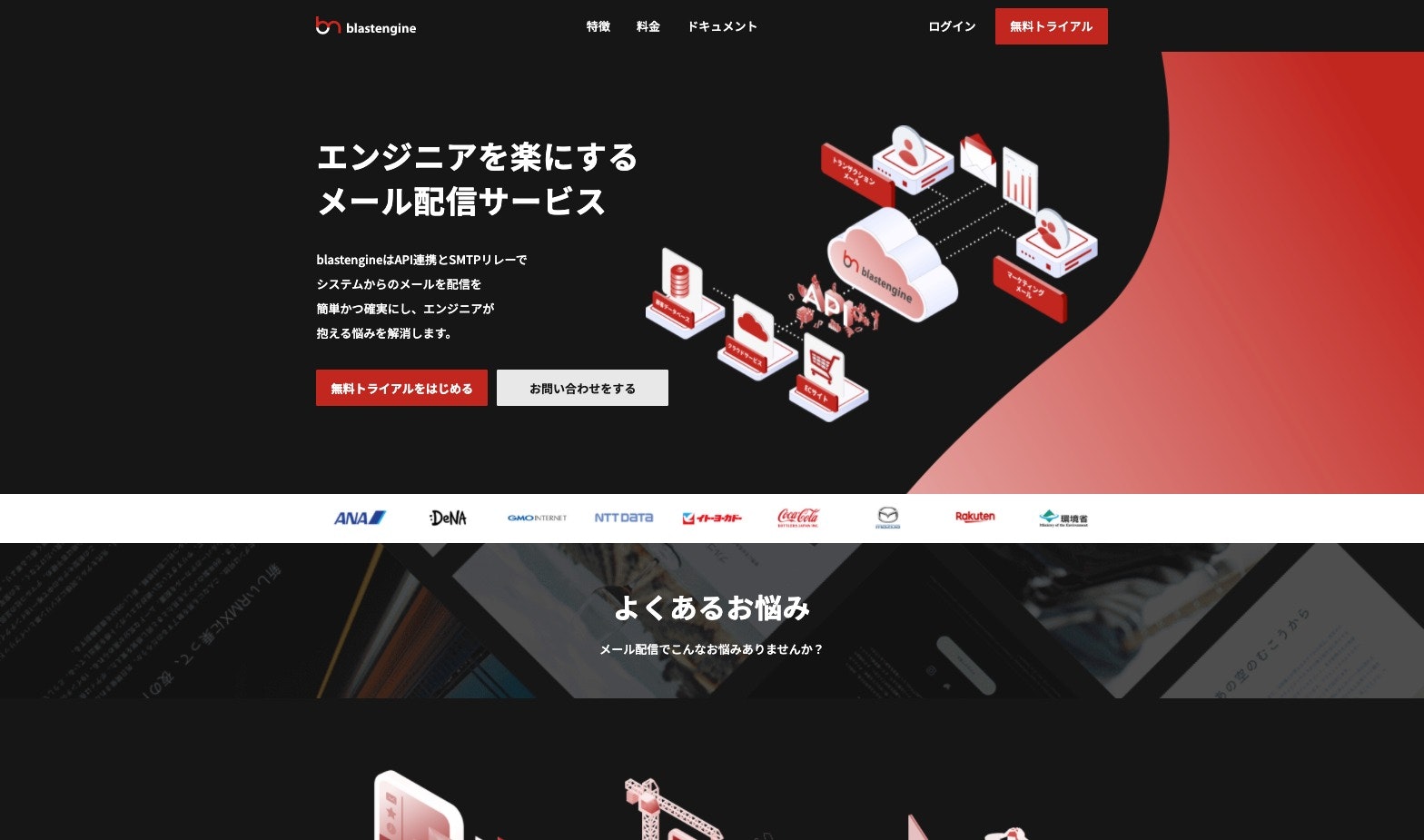blastengineはシンプルに使える開発者向けメールサービスを提供しています。何かと面倒なメール配信をシンプルに、かつ確実に送信先に届くようになります。
今回はblastengineのAPIを使ってJavaで添付ファイル付きのメール送信を行うまでの流れを解説します。
ユーザ登録する
blastengineにユーザ登録します。管理画面に入るためのユーザID、パスワードが手に入るので、ログインします(ユーザIDは後で使います)。
送信元ドメインのSPFを設定する
送信元として利用するドメイン(自分で持っているもの)の設定をします。これは任意のドメイン管理サービスで設定できますが、TXTレコードに以下のSPFを追加します。
txt @ v=spf1 include:spf.besender.jp ~all
API経由で配信する
まずはAPIを使ってHTMLメールを配信する流れを紹介します。
APIキーを取得する
ログイン後、管理画面の右上にある設定メニューに移動します。
そして設定の中で、APIキーを取得します。
クラスの準備
今回は jp.blastengine というパッケージで実装していきます。まずメール送信用のJSONオブジェクトの内容を格納するクラス BEMail を用意します。
public class BEMail {
public String subject;
public String encode;
public String text_part;
public String html_part;
public BEMailAddress from;
public String to;
}
さらにメールアドレスを入れる BEMailAddress を用意します。
public class BEMailAddress {
public String name;
public String email;
}
パッケージのインポート
必要なパッケージをインポートします。
package jp.blastengine;
// トークン生成用
import org.apache.commons.codec.digest.DigestUtils;
import java.util.Base64;
import java.nio.charset.Charset;
import java.nio.charset.StandardCharsets;
// HTTPリクエスト用
import org.apache.http.impl.client.CloseableHttpClient;
import org.apache.http.client.methods.CloseableHttpResponse;
import org.apache.http.impl.client.HttpClients;
import org.apache.http.client.HttpClient;
import org.apache.http.impl.client.HttpClientBuilder;
import org.apache.http.HttpResponse;
import org.apache.http.entity.mime.MultipartEntityBuilder;
import org.apache.http.client.methods.HttpPost;
import org.apache.http.entity.ContentType;
import org.apache.http.HttpEntity;
import org.apache.http.entity.mime.content.ContentBody;
import org.apache.http.entity.mime.content.ByteArrayBody;
import org.apache.http.entity.mime.HttpMultipartMode;
import org.apache.http.util.EntityUtils;
import org.apache.http.entity.StringEntity;
import java.io.IOException;
// JSON処理用
import com.fasterxml.jackson.core.JsonProcessingException;
import com.fasterxml.jackson.databind.ObjectMapper;
// 添付ファイル用
import java.io.*;
import java.nio.file.*;
import java.util.*;
必要な変数を準備
トークンを生成するのに必要なユーザ名とAPIキーを準備します。
String username = "USERNAME";
String api_key = "APIKEY";
トークンを生成する
APIリクエストするためのトークンを生成します。手順としては次のとおりです。
- ユーザIDとAPIキーを連結する
- SHA256のハッシュを生成する
- ハッシュを全て小文字にする
- 3の文字列をBASE64エンコードする
実際のコードで言うと、次のようになります。 token がトークンです。
String digest = DigestUtils.sha256Hex(username + api_key);
String token = new String(Base64.getEncoder().encode(digest.toLowerCase().getBytes()));
メールオブジェクトの作成
BEMail のインスタンスを作成して、必要な情報をセットします。fromのemailやtoなど、メールアドレスは利用されるものに書き換えてください。
BEMail mail = new BEMail();
mail.subject = "テストメール";
mail.encode = "UTF-8";
mail.text_part = "テストメールの本文(テキスト)";
mail.html_part = "<h1>テストメールの本文(HTML)</h1>";
mail.to = "user@example.jp";
// Fromの作成
BEMailAddress fromAddress = new BEMailAddress();
fromAddress.name = "送信者サンプル";
fromAddress.email = "info@example.com";
// Fromをセット
mail.from = fromAddress;
そして mail をJSONにします。
ObjectMapper mapper = new ObjectMapper();
String json = mapper.writeValueAsString(mail);
添付ファイルを準備する
添付ファイルを読み込んでバイト文字列にします。
final Path path = Paths.get("../README.md");
final String fileName = path.getFileName().toString();
final byte[] bytes = Files.readAllBytes(path);
MultipartEntityBuilderを作成
MultipartEntityBuilderを使って添付ファイルと、メール送信用のパラメータを準備します。
MultipartEntityBuilder builder = MultipartEntityBuilder.create();
builder.setMode(HttpMultipartMode.BROWSER_COMPATIBLE);
// 添付ファイル
ContentBody attach = new ByteArrayBody(bytes, Files.probeContentType(path), fileName);
builder.addPart("file", attach);
// メール送信情報
ContentBody jsonEntity = new ByteArrayBody(json.getBytes(), ContentType.APPLICATION_JSON, "data");
builder.addPart("data", jsonEntity);
APIリクエストする
では実際にメールを送信します。APIのエンドポイントは https://app.engn.jp/api/v1/deliveries/transaction になります。生成したトークンは Authorization ヘッダーに適用します。
// HttpPostを作成
HttpPost httpPost = new HttpPost("https://app.engn.jp/api/v1/deliveries/transaction");
// トークンをセット
httpPost.setHeader("Authorization", "Bearer " + token);
// データをセット
HttpEntity httpEntity = builder.build();
httpPost.setEntity(httpEntity);
// HTTPクライアントを作成
HttpClient client = HttpClientBuilder.create().build();
// リクエストを実行
HttpResponse response = client.execute(httpPost);
結果
レスポンスを出力します。配信ID(delivery_id)は照会、変更および削除操作に必要です。
System.out.println(EntityUtils.toString(response.getEntity()));
// { delivery_id: 9 }
全体のコード
今回のサンプルコードは次のようになります。実装時の参考にしてください。
package jp.blastengine;
// トークン生成用
import org.apache.commons.codec.digest.DigestUtils;
import java.util.Base64;
import java.nio.charset.Charset;
import java.nio.charset.StandardCharsets;
// HTTPリクエスト用
import org.apache.http.impl.client.CloseableHttpClient;
import org.apache.http.client.methods.CloseableHttpResponse;
import org.apache.http.impl.client.HttpClients;
import org.apache.http.client.HttpClient;
import org.apache.http.impl.client.HttpClientBuilder;
import org.apache.http.HttpResponse;
import org.apache.http.entity.mime.MultipartEntityBuilder;
import org.apache.http.client.methods.HttpPost;
import org.apache.http.entity.ContentType;
import org.apache.http.HttpEntity;
import org.apache.http.entity.mime.content.ContentBody;
import org.apache.http.entity.mime.content.ByteArrayBody;
import org.apache.http.entity.mime.HttpMultipartMode;
import org.apache.http.util.EntityUtils;
import org.apache.http.entity.StringEntity;
import java.io.IOException;
// JSON処理用
import com.fasterxml.jackson.core.JsonProcessingException;
import com.fasterxml.jackson.databind.ObjectMapper;
// 添付ファイル用
import java.io.*;
import java.nio.file.*;
import java.util.*;
// トークン生成に必要な情報
String username = "USERNAME";
String api_key = "APIKEY";
// トークン生成
String digest = DigestUtils.sha256Hex(username + api_key);
String token = new String(Base64.getEncoder().encode(digest.toLowerCase().getBytes()));
BEMail mail = new BEMail();
mail.subject = "テストメール";
mail.encode = "UTF-8";
mail.text_part = "テストメールの本文(テキスト)";
mail.html_part = "<h1>テストメールの本文(HTML)</h1>";
mail.to = "user@example.jp";
// Fromの作成
BEMailAddress fromAddress = new BEMailAddress();
fromAddress.name = "送信者サンプル";
fromAddress.email = "info@example.com";
// Fromをセット
mail.from = fromAddress;
// 送信情報をJSON文字列化
ObjectMapper mapper = new ObjectMapper();
String json = mapper.writeValueAsString(mail);
// 添付ファイルを処理
final Path path = Paths.get("../README.md");
final String fileName = path.getFileName().toString();
final byte[] bytes = Files.readAllBytes(path);
// リクエストデータを作成
MultipartEntityBuilder builder = MultipartEntityBuilder.create();
builder.setMode(HttpMultipartMode.BROWSER_COMPATIBLE);
// 添付ファイル
ContentBody attach = new ByteArrayBody(bytes, Files.probeContentType(path), fileName);
builder.addPart("file", attach);
// メール送信情報
ContentBody jsonEntity = new ByteArrayBody(json.getBytes(), ContentType.APPLICATION_JSON, "data");
builder.addPart("data", jsonEntity);
// HttpPostを作成
HttpPost httpPost = new HttpPost("https://app.engn.jp/api/v1/deliveries/transaction");
// トークンをセット
httpPost.setHeader("Authorization", "Bearer " + token);
// データをセット
HttpEntity httpEntity = builder.build();
httpPost.setEntity(httpEntity);
// HTTPクライアントを作成
HttpClient client = HttpClientBuilder.create().build();
// リクエストを実行
HttpResponse response = client.execute(httpPost);
// 結果
System.out.println(EntityUtils.toString(response.getEntity()));
まとめ
クラウドサービスではSMTPポートが塞がれている場合があるので、そうした時にはAPI経由を利用してください。SMTPリレーを使えば、より信頼性高く、安定した配信が実現できるでしょう。
APIとSMTPリレー、それぞれの要件に合わせて最適な方を選択してください。


